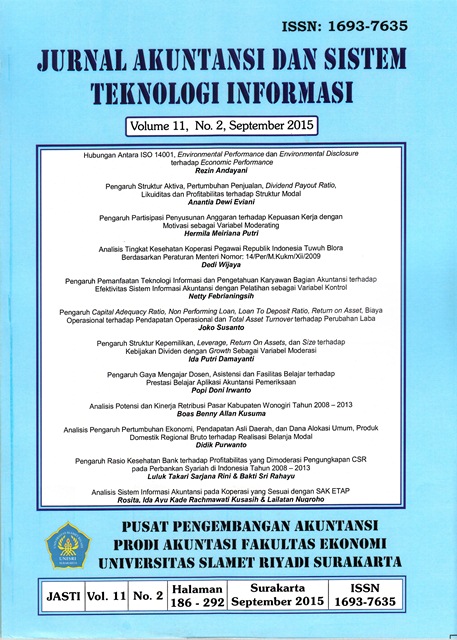PENGARUH RASIO KESEHATAN BANK TERHADAP PROFITABILITAS YANG DIMODERASI PENGUNGKAPAN CSR PADA PERBANKAN SYARIAH DI INDONESIA TAHUN 2008 – 2013
Abstract
This research is based on survey to the secondary data from the Annual Report (2008 – 2013) of PT Bank Syariah Umum that have been listed by Bank Indonesia. The aims of this research is to know the effect of Capital Adequacy Ratio(CAR), Non Performing Financing (NPF), Net Interest Margin (NIM), Financial to Deposit Ratio (FDR), and Corporate Social Resposibility (CSR) on the effect on the Return On Asset (ROA) for Perbankan Umum Syariah Indonesia. The sampling technique of the research is done by sensus sampling method to obtain sample that adequate with the aims of the research. The population technique is the all of PT Perbankan Umum Syariah that have been listed by Bank Indonesia. The statistical analysis for to reach the aims of this research are normality test (Kolmogorov-Smirnov Test), non-parametric test (Kruskal-Wallis Test), tests of multiple linear regression model that consist of t-test, F-test (Anova), Stepwise regression test, and R2 test (Coefficint Determinant Test. The result of this research show that NIM variable together with interaction between FDR and CSR significant effect on ROA P-Value = 0,010 < 0,05,with koefisien determinan R2 (adjust) = 21,3 percent. Keywords: Capital Adequacy Ratio (CAR), Non Performing Financing (NPF), Net Interest Margin (NIM), Financial to Deposit Ratio (FDR), Corporate Social Responsibility (CSR), Corporate Social Responsibility (CSR)Downloads
Published
2016-01-13
Issue
Section
Artikel
License
Authors who publish this journal agree to the following terms:
- Authors retain copyright and grant the journal right of first publication with the work simultaneously licensed under a Creative Commons Attribution License that allows others to share the work with an acknowledgement of the work's authorship and initial publication in this journal.
- Authors can separately make additional contractual arrangements for non-exclusive distribution published by the journal (e.g., publish it in a book), with an acknowledgement of its initial publication in this journal.
- Authors are allowed and encouraged to send their work via online (e.g., in the institutional repositories or their website) after published by the journal.










